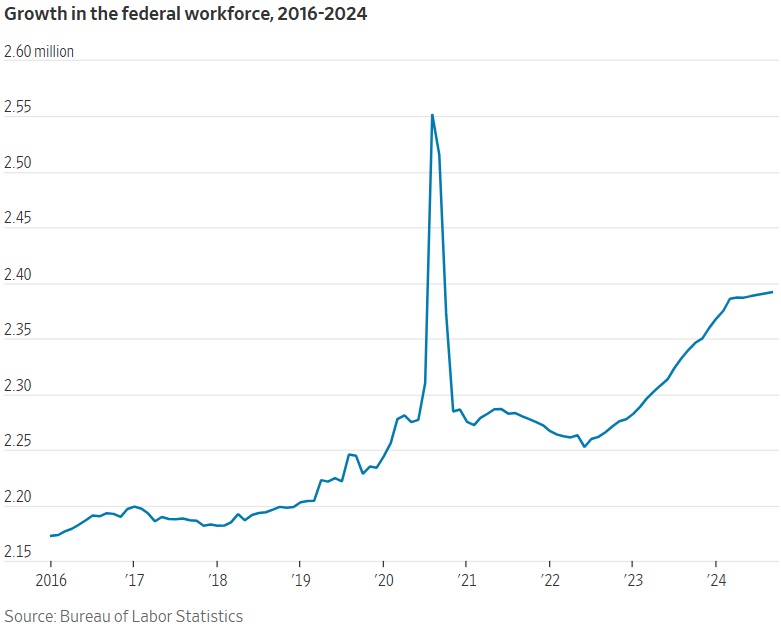Much to my surprise, the United States is going to have a second Trump presidency, writes Dan Mitchell.
To assess what that means, especially considering his mixed performance during his first four years, I’m going to write a series of columns about the potential policy implications.
We’ll start by looking at America’s massive bureaucracy. Here’s a chart from the Saint Louis Federal Reserve that shows how much total government employment has increased since Biden took office.
It’s important to look at the total number of bureaucrats because many state and local bureaucrats are directly or indirectly funded by the federal government.
If the federal bureaucracy shrinks, but only because jobs have shifted to state and local government, that’s not progress.
With that important caveat on the table, let’s now specifically examine the size of the federal bureaucracy. The Wall Street Journal has an excellent editorial on this issue. Here are some excerpts.
The federal workforce…has exploded in the Biden era. Since January 2021, the federal workforce has increased by about 120,800 employees. Washington has added as many workers in the last two years as during the prior 13. …employment has ballooned across nearly the entire government, as quarterly data from the Office of Personnel Management show. …employment has increased sharply at the Environmental Protection Agency (9.4%), Agriculture Department (9.6%), Department of Housing and Urban Development (10.7%), Internal Revenue Service (14%), Energy Department (14.8%), State Department (18.4%) and Health and Human Services (18.7%). Independent agencies have also mushroomed, including the Consumer Financial Protection Bureau (9.8%), Securities and Exchange Commission (11.1%) and Federal Trade Commission (11.6%). …What are all of these new bureaucrats doing? Writing new rules and mandates for the rest of America to live by, and to punish citizens who don’t comply. …New rules can run to hundreds of pages and require battalions of lawyers, accountants and consultants to comply.
Here’s a chart that accompanied the editorial.
It shows the size of the federal workforce from 2016 until today.

There are three things that deserve attention, one that is trivial and two that are important.
- First, there’s always a spike with the federal government does a census, so that’s why federal employment jumped to more than 2.5 million in 2020. But those jobs fortunately disappear when the census was completed.
- Second, notice how the size of the federal bureaucracy expanded under Trump. He did okay his first two years, but then we got a lot more bureaucrats his last two years (not counting census workers).
- Third, Biden also did not cause much damage his first two years, but the federal bureaucracy has dramatically expanded over the past two years. That’s a very worrisome trendline for the nation’s taxpayers.
The bottom line is that Trump will have to restrain government if he wants to restrain bureaucracy.
He didn’t do that his first term. We can hope it happens in a second term.


